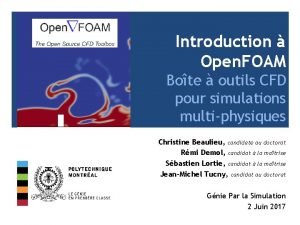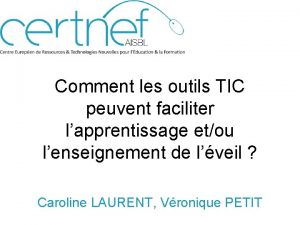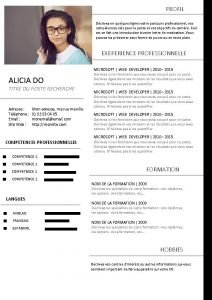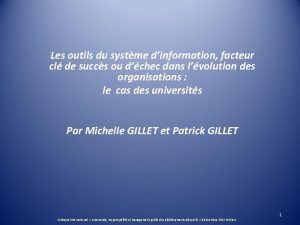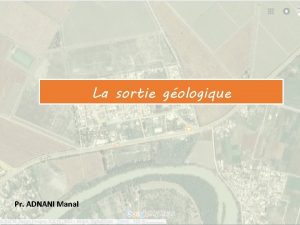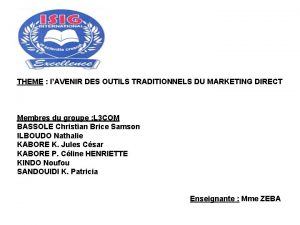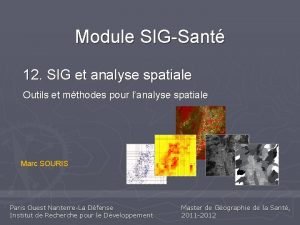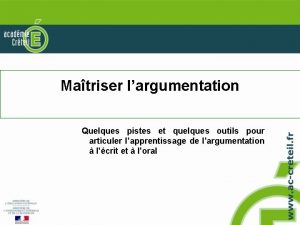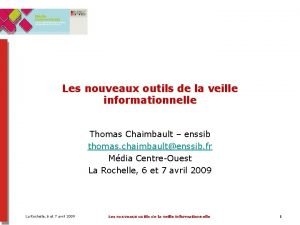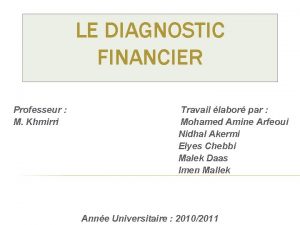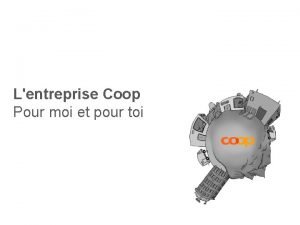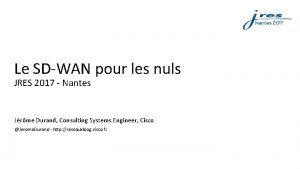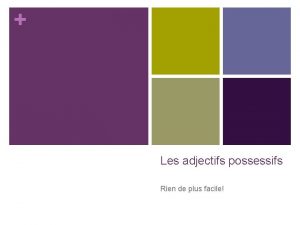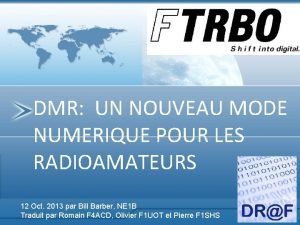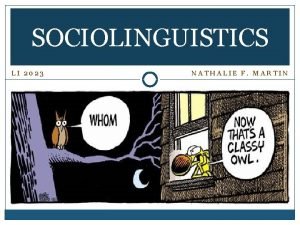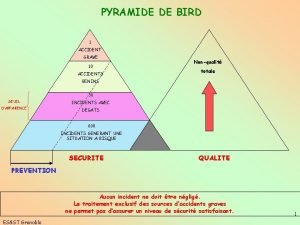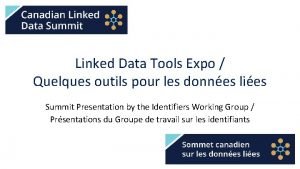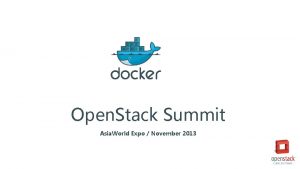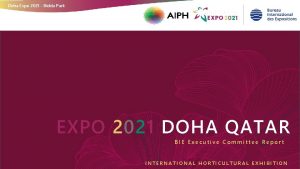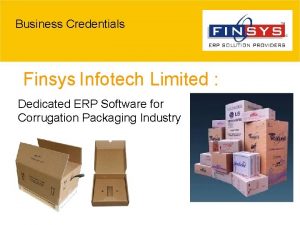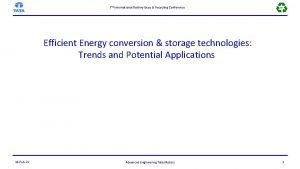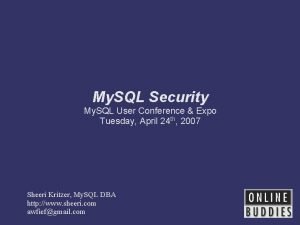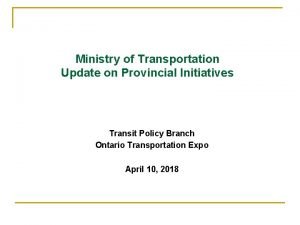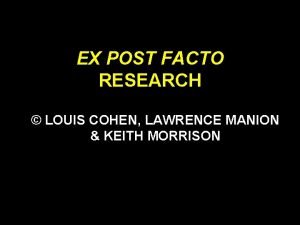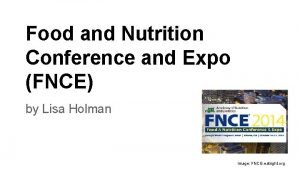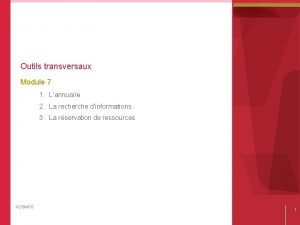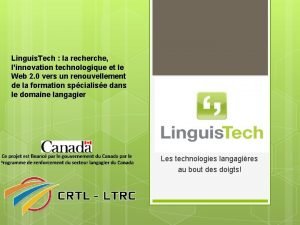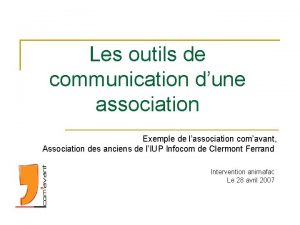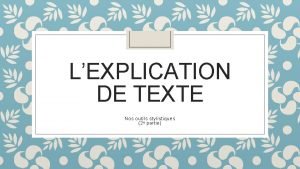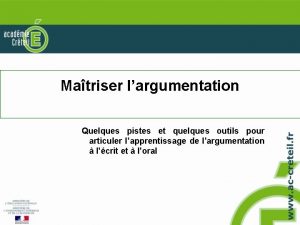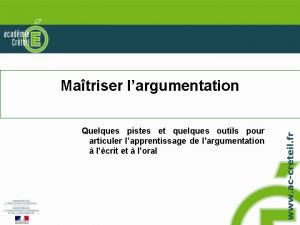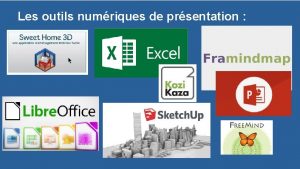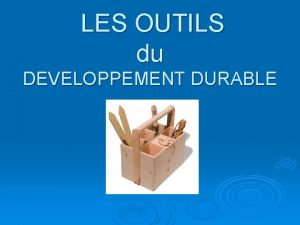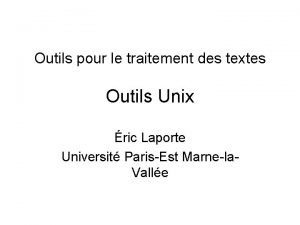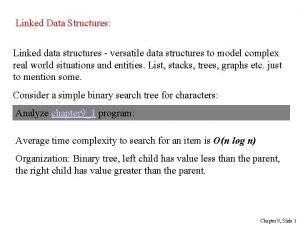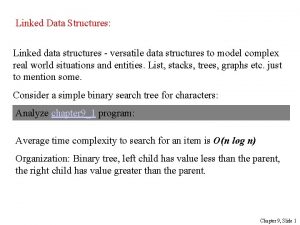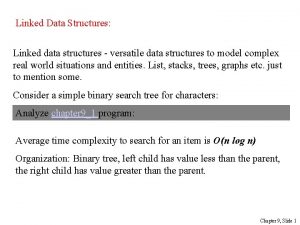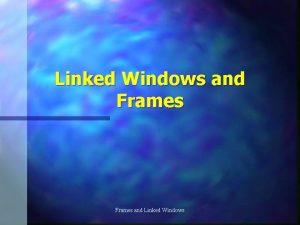Linked Data Tools Expo Quelques outils pour les































































- Slides: 63

Linked Data Tools Expo / Quelques outils pour les données liées Summit Presentation by the Identifiers Working Group / Présentations du Groupe de travail sur les identifiants

Moving us from Theory to Practice De la théorie à la pratique Less talk, more action: seeing the benefits of linked data through practical application De la parole aux actes : démontrer les avantages données liées par la pratique Using linked data tools in our library workflows / Des outils pour les données liées à utiliser dans nos chaînes de travail : MARC Next Open Refine RIMMF Protégé Examples, potential value, application readiness, successes and challenges Exemples, potentiel et maturité des outils, succès et défis

Créer des autorités enrichies avec Marc. Next Julie Cardinal Directrice | Traitement documentaire et métadonnées Sommet canadien sur les données liées 25 octobre 2016

Projet Créer des autorités dans notre catalogue (Aleph) pour les directeurs de recherche à partir d’une liste de noms extraite du dépôt institutionnel Papyrus (DSpace) Créer rapidement des autorités dans le catalogue Ajouter l’affiliation à l’Ude. M Ajouter un numéro normalisé (identifiants LC et VIAF) Permettre de faire des liens avec d’autres bases de données Ude. M

Outils Marc. Next Conçu pour aider les catalogueurs à expérimenter de nouveaux modèles de données et faciliter la transition du MARC vers celui des données liées • Intégrer des modèles de données liées dans Marc. Edit (URI, SPARQL, RDF, etc. ) • Fournir des outils en vue de valider les concepts • Méthode pour intégrer des données liées dans les données existantes Accent sur l’outil Link Identifiers • Permet l’intégration des URI dans les données MARC • Ne repose pas sur des données en Marc 21 • Offre accès aux données de VIAF, service LC Linked Data, et plusieurs autres

Comment - Étapes préalables à Marc. Edit Étape 1 Étape 2 Étape 3

Comment - Étapes dans Marc. Edit Étape 1

Comment - Étapes dans Marc. Edit Étape 2

Comment - Étapes dans Marc. Edit Étape 3

Comment - Étapes dans Marc. Next Résultat final 60% des notices enrichies avec au moins un identifiant

Difficultés rencontrées / Limites Marc. Next n’ajoute pas d’URI sur les 1 XX autorités Peut-être lent à générer les URI, spécialement avec un lot important de notices Moins performant sur les autorités Pas d’URI ajouté en provenance de LC alors qu’il y a une autorité dans id. loc. gov

Difficultés rencontrées / Limites Mauvais URI ajouté =LDR 00000 nz 2200000 n 4500 =008 161013 nneaznnnaabn\\? ? a? a\\d =040 \$a. Ca. QMU$bfre$erda$d. Ca. QMU =100 10$a. Sabourin, Paul$0 http: //id. loc. gov/authorities/names/n 84076781$0 http: //viaf. org/viaf/161135265 =373 \$a. Université de Montréal

Potentiel d’utilisation dans la chaîne de traitement Avantages • Outil simple d’utilisation, à la portée de tous • Intégré à Marc. Edit et sa suite d’outils (Z 39. 50, Déduplication, etc. ) Désavantages • Moins bien adapté pour les autorités non validées • Validation manuelle encore nécessaire • Processus lourd pour enrichir les données existantes … permet une introduction au monde des données liées

Marc. Next: Link Identifiers for Bibliographic Records Ian Bigelow Cataloguing Coordinator | University of Alberta Canadian Linked Data Initiative Summit October 25 th, 2016

Marc. Next Tools Designed to help cataloguers experiment with new data models and aid in the transition from MARC to Linked Data • Integrating linked data concepts into Marc. Edit (URI, SPARQL, RDF, etc. ) • Provides a suite of proof of concept tools • Method to integrate semantic concepts into legacy data Focus on the Link Identifiers tool • Integration of URI in MARC data • Not MARC centric • Access to data from VIAF, LC Linked Data Service, and many more

Marc. Next: Link Identifiers for Bibliographic Records 1. Walk-through In MARCEdit go to: MARCNext>Link Identifiers Note: Under MARCEdit “Validate Headings” tool, you can also embed URI during the validation process.

Link Identifiers Auto. Detect Main/Added Entry: Check to enrich data with URI for selected name authority file. Subject ID: Check to enrich data with URI for subjects 3 xx: Adds URI for RDA content/media/carrier from id. loc. gov OCLC VIAF/LC(NACO): Selects the data to use OCLC Work ID: Adds experimental OCLC Work ID to 787 field

Before

After

2. Challenges and Strengths Challenges: • Speed • 6 xx subfields • Worldcat work ID • Know your data and understand the process Strengths: • Free and easy setup • Directly tied to MARCEdit (every cataloguer’s favorite tool suite) - Makes it great for training and experimentation • Works well in concert with LOD/Open. Refine and data visualization tools

3. Context and Applications : URI in MARC Bibliographic

By working with URI in MARC we can work through best practices and alternate approaches

We can even think about how this might look in local workflow!

But Why!? Training/Experimentation Prepare our “legacy” MARC data for future bibliographic transitions Reflect on implications for authority control Enhance discovery and analysis of our data through linking As Karen Coyle noted in Linked data first steps & catch-21, with the use of just one solitary URI a wealth of information can be made discoverable: “In the LC identifier service, the name authority data includes a link to the VIAF identifier for the person; the VIAF identifier for some persons is included in the Wikipedia page about the person; the Wikipedia identifier links you to DBpedia and the DBpedia identifier is used by Freebase. . . That's how it all gets started, with one identifier that becomes a kind of identifier snowball rolling down hill, collecting more and more links as it goes along. ” (Coyle, 2013)

. . . Let’s have a snowball fight! https: //viaf. org/viaf/145660798/

. . . And explore connections/patterns/relationships in our data

Open. Refine Andrew Senior Coordinator, E-Resources and Cataloging (Serials) Mc. Gill University Canadian Linked Data Initiative Summit October 25 th, 2016

Open. Refine http: //openrefine. org/ Visualization, manipulation, cleaning of data Sort, filter, facet, cluster, General Refine Expression Language (GREL) Programme for Windows, Mac, Linux OS Runs on local server but does not open up your data to the internet Interface looks simple, but is powerful at cleaning data Working memory means reverting to any stage of the work is possible (Ruben Verborgh and Max De Wilde, 2013)

Open. Refine - Imports many kinds of data files CSV, TSV, Excel, *SV, JSON, XML, RDF as XML, Google Data. . .

Use of Open. Refine - Reviewing KBART Files

Identifying Duplicates Through Text Facet

Identifying Duplicates Through Text Facet

Marc. Edit and Open. Refine Marc. Edit has Export/Import option for Open. Refine Converts Marc. Edit’s mnemonic format and Marc binary file to json or tsv

Experimenting with DERI RDF Extension Not part of regular Open. Refine but must be added separately Can be tricky to install Enables additional functionality for RDF files Possibility of using external SPARQL endpoints and RDF files to reconcile data with external data values (Verborgh & De Wilde, 2013) DERI RDF Extension no longer supported and original Freebase reconciliation service no longer available (Christina Harlow, 2015)

Working with RDF in Open. Refine

Working with RDF in Open. Refine

Open. Refine in a Technical Services Environment Value: • Experimentation for staff who are not necessarily familiar with metadata concepts and tools • More straightforward data cleaning and combining with other tools is beneficial to workflows • Encountering different serialisations, more complex data manipulations and difficulties (i. e. why doesn’t my reconciliation work? ) forces research into issues = increased knowledge • Documentation available from many sources and draws on community involvement (books, presentations, articles, videos) Future Steps: • Learning to use Open. Refine’s Reconciliation Service API

Open. Refine in a Technical Services Environment Challenges: • Not everyone is at home in the more experimental environment that Open. Refine sometimes fosters • Future-proofing? What types of support will be present over long-term? Personal Future Step: • More learning: Using Open. Refine’s Reconciliation Service API

RIMMF (RDA in Many Metadata Formats) Marlene van Ballegooie Metadata Technologies Manager | University of Toronto Libraries Canadian Linked Data Initiative Summit October 25 th, 2016

What is RIMMF? RIMMF is an open source visualization and educational tool for creating and editing data compliant with RDA, FRBR, and linked data Developed as a training tool to allow cataloguers to create RDA metadata independent of MARC Excel MARC 21 Text (RIMMF format) XML RDF Linked Data

How is RIMMF Used? RIMMF is the primary tool used in recent Jane-athons Half or full day workshops using RIMMF to explore using RDA beyond the limitations of MARC Main product of a Jane-athon is the creation of an r-ball, a collection of RDA linked data based on an entity such as a person or work R-balls may contain data about Works, Expressions, Manifestations and Agents related to a particular entity

Playing with RIMMF Experimentation with RIMMF to conduct a personal “Marg-athon” - a tribute to Margaret Atwood and her works Import bibliographic and authority records, analyze the differing RDA visualizations, export to RDF linked data

How RIMMF Works Import MARC records…

RDA FRBR Display

Work Tree Visualization in RIMMF Illustrates relationships between Works, Expressions and Manifestations, as well as between Agents and related entities

RIMMF Entity Index

RIMMF RDA Registry: http: //www. rdaregistry. info/

RIMMF: Implementation and Use RIMMF is currently available only for Windows users Trouble-free installation User interface is not very intuitive Introductory training session / tutorials are helpful for understanding how to use the tool http: //www. marcofquality. com/wiki/rimmf 3/doku. php? id=examples

Uses of RIMMF in Technical Services Cataloguing tools lag behind new trends in metadata creation Technical services is moving towards a hybrid environment (MARC/BIBFRAME) Cataloguers need to get out from behind the curve and become educated in new data modeling techniques RIMMF helps cataloguers think outside of the MARC record structure

Protégé: An Ontology Editing Tool Hong Cui Cataloguing Librarian |Bibliographic Description Library and Archives Canada Canadian Linked Data Initiative Summit October 25 th, 2016

Protégé: What is the tool? Open-source ontology editor developed by Stanford Center for Biomedical Informatics Research. • Web Protégé • Desktop Protégé Fully supports the latest OWL (Web Ontology Language) and RDF specifications from the World Wide Web Consortium Can contains both Ontology and Individuals in the Protégé project Over 306, 596 users

Web Protégé Create, upload and download projects after creating a user account • Support upload and download of ontologies in multiple formats (RDF/XML, Turtle, OWL/XML, OBO, and others) • Share project with other people so that they can view, comment or edit it. Track the history of changes made by the author and time • Project dashboard provides an overview of the activity in the ontology URL: http: //webprotege. stanford. edu/#List: coll=Home;




Desktop Protégé Supports creating and editing one or more ontologies in a single workspace Visualization tools allow for interactive navigation of ontology relationships Refactor tools including ontology merging, moving axioms between ontologies, renaming multiple entities, and etc. Reasoning tools: DL query tab to test arbitrary class expressions, direct interface to Fa. CT++reasoner, and Pellet reasoner, inferred axioms showing up in most standard view


Protégé Support Mailing list Documentation, including the WIKI pages Hands-on courses available @ Stanford

Create ontology in protégé: Pizzas in 10 Minutes http: //protegewiki. stanford. edu/wiki/protege 4 pizzas 10 minutes

Why do we need an ontology editing tool? Create an ontology project for a unique collection Reuse the ontology / taxonomy established by recognized institution Learning tool to understand basic RDF schema • Understand the classes and properties • Understand the hierarchy of classes and properties (class-subclass, property-subproperty) • Understand domain and range specifications • Understand the relationships between properties, domain, range, classes, and individuals • Understand the difference between inferred triple statement and asserted triple statements

Tools Help Take Us from Theory to Practice Passez de la théorie à la pratique : les outils sont là pour vous! Let’s roll up our sleeves and get to work! Permettez-vous de : • Experiment – Expérimenter • Document – Documenter • Share successes and failures – Partager les bons et mauvais coups

Bibliography Bigelow, I. , Boileau, S. , Emon, D. , Leung, R. , Morgan, M. & Sillius, I. (2015). OCLS cataloguing workflow. Toronto, ON: OCLS. Retrieved from: https: //www. ocls. ca/sites/default/files/attachments/OCLS_CAT_Workflow_23 Oct_1. pdf Coyle, K. (2013, July 23). Linked data first steps & catch-21 [blog post]. Retrieved from: https: //kcoyle. blogspot. ca/2013/07/linkeddata-first-steps-catch-21. html Harlow, C. (2015). Building Your Own Open. Refine Reconciliation Service. Code 4 Lib MDC Open. Refine Workshop Presentation. Retrieved from https: //github. com/cmh 2166/c 4 l. MDCpres Marc. Edit : Linked Data linking tools update https: //www. youtube. com/watch? v=9 ER 5 cl. ALO 6 g Reese, T. (2016, January 16). Marc. Edit and Open. Refine [blog post]. Terry’s worklog. Retrieved from http: //blog. reeset. net/archives/1873 Shieh, J, & Reese, T. (2015). The importance of identifiers in the new web environment and using the Uniform Resource Identifier (URI) in subfield zero ($0): a small step that is actually a big step. Journal of Library Metadata, 15(3 -4), 208 -226. doi: 10. 1080/19386389. 2015. 1099981 Verborgh, R & De Wilde, M. (2013). Using Open. Refine. Birmingham, UK: Packt Publishing.

Thank you! Questions?
 Construire les premiers outils pour structurer sa pensée
Construire les premiers outils pour structurer sa pensée Outils pour les cfds
Outils pour les cfds Les outils pédagogiques pour faciliter lapprentissage
Les outils pédagogiques pour faciliter lapprentissage Composition dragibus
Composition dragibus Un texte expressif
Un texte expressif Décrivez en quelques lignes votre parcours professionnel
Décrivez en quelques lignes votre parcours professionnel Apres quelques temps tu apprendras
Apres quelques temps tu apprendras Les outils de facteur
Les outils de facteur Les outils de la veille mercatique et commerciale
Les outils de la veille mercatique et commerciale Les outils de la sortie géologique
Les outils de la sortie géologique Outils de description
Outils de description Outils de communication traditionnels
Outils de communication traditionnels Les outils de l analyse spatiale
Les outils de l analyse spatiale Les outils de largumentation
Les outils de largumentation Def veille informationnelle
Def veille informationnelle Les outils du diagnostic financier
Les outils du diagnostic financier Les 7 outils de la loi 2002-2
Les 7 outils de la loi 2002-2 Toi et moi basel
Toi et moi basel Singly linked list vs doubly linked list
Singly linked list vs doubly linked list Singly vs doubly linked list
Singly vs doubly linked list Perbedaan single linked list dan double linked list
Perbedaan single linked list dan double linked list Pour toutes les mamans
Pour toutes les mamans Pour les enfants du monde entier
Pour les enfants du monde entier Sdwan pour les nuls
Sdwan pour les nuls A toutes les mamans du monde
A toutes les mamans du monde Il faut chanter pour toutes les mamans du monde
Il faut chanter pour toutes les mamans du monde Il faut chanter
Il faut chanter Outil pour arracher les dents
Outil pour arracher les dents Les adjectifs démonstratifs s'utilisent pour
Les adjectifs démonstratifs s'utilisent pour Dmr pour les nuls
Dmr pour les nuls Chiac pour les dummies
Chiac pour les dummies Ordre du jour pour les enseignants
Ordre du jour pour les enseignants Pyramide des risques
Pyramide des risques бетмига
бетмига Master sciences analytiques pour les bioindustries
Master sciences analytiques pour les bioindustries Le 4 lois spirituel
Le 4 lois spirituel Comment rendre sa femme heureuse
Comment rendre sa femme heureuse Vt engineering expo
Vt engineering expo Craft distilling expo
Craft distilling expo Opsigelse eksempel
Opsigelse eksempel Science expo background
Science expo background Small business expo chicago
Small business expo chicago Asme turbo expo 2014
Asme turbo expo 2014 Expo docker
Expo docker Reinvent your career expo
Reinvent your career expo Doha expo 2021 project
Doha expo 2021 project Finsys infotech pvt ltd
Finsys infotech pvt ltd Expo
Expo Expo sql
Expo sql Franchise expo 2015
Franchise expo 2015 Fielders pro shop brookhaven ms
Fielders pro shop brookhaven ms Ontario transportation expo
Ontario transportation expo Ex post facto research in education
Ex post facto research in education Ex post facto prospectivo simple
Ex post facto prospectivo simple Food and nutrition expo
Food and nutrition expo Expo elastix
Expo elastix Outils transversaux
Outils transversaux Outils pédagogiques définition
Outils pédagogiques définition Outil linguis
Outil linguis Outils du géographe
Outils du géographe Outils de communication association
Outils de communication association Boite outils sem
Boite outils sem La métonymie
La métonymie Outils stylistiques
Outils stylistiques

